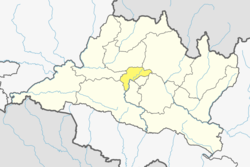Dahachok दहचोक | |
|---|---|
Village of Chandragiri Municipality | |
 Dahachowk | |
| Coordinates: 27°42′39″N85°13′42″E / 27.71083°N 85.22833°E | |
| Country | |
| Province | No. 3 |
| District | Kathmandu District |
| Population (2011) | |
• Total | 4,036 |
| Time zone | UTC+5:45 (Nepal Time) |
Dahachok is a village and former Village Development Committee that is now part of Chandragiri Municipality in Kathmandu District in Province No. 3 of central Nepal. At the time of the 2011 Nepal census it had a population of 4,036. [1] It is located in the west of Kathmandu .




